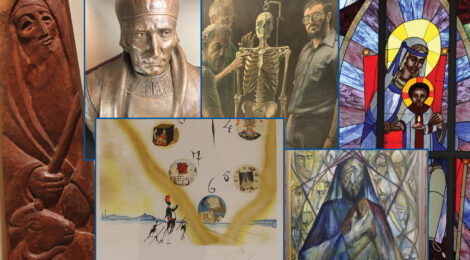
Art@ThomasMore – Stained Glass Windows by Sr. Emmanuel Pieper
Hello, I’m Judy Crist and I am a member of the Art at Thomas More initiative. This series is designed to shed light on the amazing artwork and artifacts that are part of the permanent collection at Thomas More University. Today we’re featuring the stained glass windows in Mary, Seat of Wisdom Chapel. The Chapel was built and dedicated in 2012 as a free-standing place of worship for the entire Thomas More community. The windows were designed by Sr. Emmanuel Pieper, who is a member of the Order of St. Benedict and longtime art teacher at Villa Madonna Academy. In addition to being an educator, Sister Emmanuel is a free-lance artist and her artwork: paintings, windows, and banners can be found throughout the region as well as the country.
The windows featured in the Chapel include the Christian Life, Mary Seat of Wisdom, and the Academics along the northeast wall; flames representing the Holy Spirit which is above the sanctuary, Jesus teaching the beatitudes which is in the meditation chapel, and a young Saint Thomas More which is in the entry way. There are also windows honoring the three religious orders who helped in the early years of the college: the Order of St. Benedict, Sisters of Notre Dame, and Sisters of Divine Providence. We spoke to Sister Emmanuel about her part in designing the windows and also about how she learned the art of stained glass in her earlier years from Walter Bambach, who was the owner of Riordan Glass Company when it was located in Covington, Kentucky.
Sr. Emmanuel Pieper: I used to work with a real genius, a real genius. He (Walter Bambach of Riordan Glass Company) was an old German, and he learned his stained glass craftsmanship from working with the Cistercians in Austria after World War II. He came to the states because they were put in a concentration camp. I didn’t know, there’s so many things you don’t know when a war is over and I don’t know whether it was the Americans or the Russians are who, went through Europe. He and his family were living in Czechoslovakia, but they were German descent. So they were picked up and put in a concentration camp after the war was over. The mother said, we’ll never make it through the winter on this, we’re going to have to get out of here some way and they got out. His family did make it to Austria, and he entered a Cistercian monastery. I think he was just 14-15 years old at the time and he was given to a Father Peter who had the windows from the great cathedrals of Europe that had been damaged with the bombings during the war. It was up to him to repair them and see that they got back. He was a genius with stained glass. He was in Covington for a long time. He had a big old building down there and on one side of it, he had a huge glass window and whenever I worked with him he would put the stained glass up on that window with little dabs of wax, and paint the black lines in between and then he called me. He’d say, “Sister you come now. We look it over and see if everything on it is exactly right,” and almost never, almost never did I have to change a thing.
When they were doing the Chapel, I think the community was asked for a sizable donation. So, the prioress said, “Well, if you want somebody to do stained glass, I’ll get Sister Emmanuel to do it for you.” So I was glad to do it. I’m just glad to do anything like that, I take it to people, I give them a colored picture. If they don’t like it, they don’t have to take it. If they want something change on it, I change it. The only thing they told me about the windows were that they wanted them to be really strong light sources. So I thought well, fine, I’ll put the design strongly at the bottom, and I’ll leave the top relatively plain, I’ll put something up there on all of them that kind of ties it in with the bottom and we’ll see how it goes. They gave me a very free hand with the subject matter and so I chose the Christian life window in the front, the Mary window in the center, and the academic window on the end. And they liked that. Sister Margaret Stallmeyer was wonderful to work with, she’s such a beautiful lady.
The one that I like, I like that first one in the front that’s the Christian life window. That one is on baptism, entrance into the church, and the life of the Christian in the eucharist, and the incense of prayer. And of course that would make something go up nicely through the top. This one I use the star for Mary, the star of the sea and these are things from the litany: queen of peace, mystical rose, mother most pure, and tower of David. They wanted Thomas More as a young man and I think that’s probably the closest to exactly what I had set up.
To read the 2012 original article about the production of the Mary, Seat of Wisdom stained glass, CLICK HERE.

Comments are closed, but trackbacks and pingbacks are open.